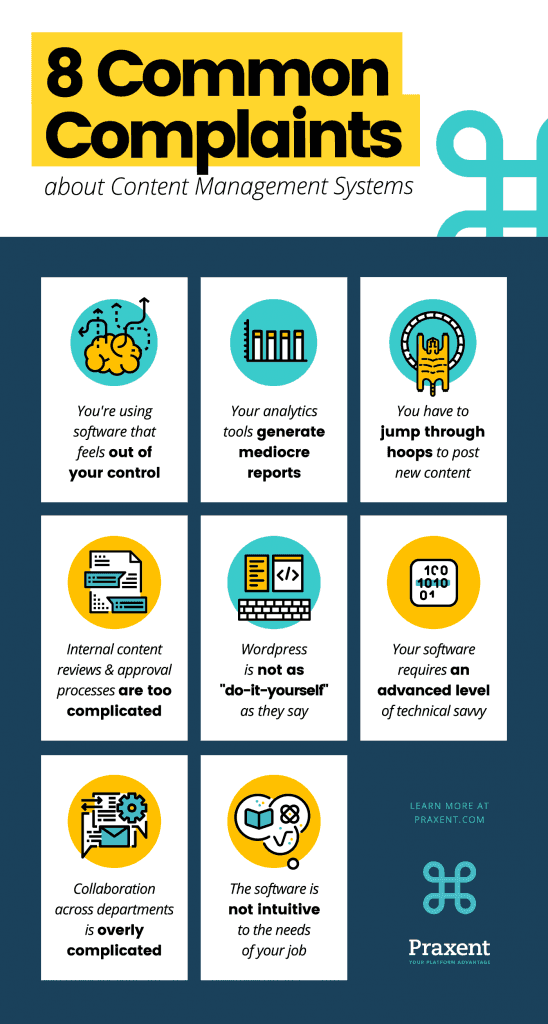
7 min read
8 Common Complaints about Content Management Systems
8 Common Complaints about Content Management Systems
Content is king these days, and your content management system is its chariot. Unfortunately, some chariots struggle under the weight of the rider — so the servants pick up the slack. (That’s you, marketers).
Marketing teams function like mini newspapers. They’ve got editors, writers, and journalists (or just one person wearing all three hats) all focused on telling stories that get the company’s product or service in front of the right audiences.
All of this while working with the sales team on defining and understanding the customer, working with the PR person on getting in front of relevant publications, and trying to track backlinks, bounce rates, and page views for the company website to see whether any of the content is actually working.
Marketers thrive on the fast-paced, ever-evolving demands of their jobs. But if there’s one thing that makes them cry at night, it’s a bottle-necked, outdated content management system.
>> Learn how to free yourself from bottlenecks with process automation.

Reasons Why You Might Hate Your Current Content Management System
1. You’re using software that feels out of your control. For example, you know it’s running too slow, but you’re unsure if this is your fault or the result of some hidden setting somewhere in the back. Do you have too many files? Is there a way to make it faster that you just don’t know about?
You’ve taken all of the user courses and watched the How To videos. Your next step will probably be to reach out to customer support — which has been only mildly effective in the past. You feel stranded with a problem that you’re not empowered to fix.
2. Your analytics tools generate mediocre reports. They’re great at illustrating a few key areas of data, but they ignore metrics that are crucial to understanding your customer and the efficacy of your content.
3. With your current content management system you’re actually forced to rely on someone else to be able to post new content.
For example, you may be marketing for a company that has a developer-centric website. Every time you need to post a blog, update a picture, or change a header, you have to go through the website developer. The developer usually doesn’t want to hear from you and you spend an unreasonable amount of time trying to persuade her to help you out.
One of our clients, Flex, experienced something similar with a website design agency they contracted out. The agency built them a beautiful website, but the website came with a 46-page handbook on how to manage the site. Everything from posting content to changing colors or adding columns required intent study before anyone on the marketing team could make it happen.
Content management systems like this were built for someone, but they weren’t built for you.
>> New website not performing? If so, you’re not alone. Learn how Flex turned it around.
4. If you work for a large corporation with lots of internal stakeholders, collaborating with other departments and getting approval on content can be a nightmare. Your content management system may not even address this issue. And if it does, you probably have to work with a lot of red tape related to user settings, permission levels, and content types.
What’s more, the system likely doesn’t offer a way for stakeholders to view the final product as part of the approval process. Instead, you’re stuck with passing around documents in Word format.
Because of this system deficiency, you lose the opportunity to “wow” stakeholders with the end product. And you may even invest in typesetting the document, which is a step you could skip if your content management system allowed you to share the final product before actually publishing.
5. Using WordPress? It’s marketed as a do-it-yourself platform, but the reality is that you really need expert knowledge to make the most of its capabilities. This is especially true if you have a clear idea of something you’d like on your website, but you can’t seem to piece the feature together using plugins and your current level of code fluency.
6. Ease-of-use is a huge problem. You may be a quick study on different technologies, but some of the older-generation stakeholders you work with are not. Isn’t there some sort of solution that caters to multiple levels of technical savvy?
7. If you’re working at the enterprise level, chances are, you’d like collaboration with the other departments to be a little easier. Perhaps you’re stringing it all together using Zapier automation or Excel spreadsheets. Even with the complex network of solutions that has evolved to meet your company’s needs, it still seems like around every corner there is a roadblock preventing smooth collaboration.
8. At the end of the day, the software is simply not intuitive to the needs of your job. And it’s not built to think like you.
Inefficient Document Management Systems
The problem extends beyond public-facing content management to internally focused document management. With document management, security and data analytics are top priority. Companies need to be able to share documents of all sorts across departments and with various stakeholders, all while managing user levels, and permissions, getting approvals and collaborating on drafts.
Ideally, document management systems should facilitate easy analysis as well. Somehow, companies need to be able to glean data from the documents they create so that they can track progress, develop business strategy, and course correct.
With the exception of some businesses, off-the-shelf document management system software is rarely sufficient to meet all of these requirements because needs vary so extensively across industries and even within industries.
Enough Said.
Your time is short and there is not enough of it. We get that. In fact, it’s about time someone came along and disrupted the whole thing.
Why not you? We can partner with you to create a custom solution for all of your industry-specific content management needs. With an incredibly intuitive system that’s fully adapted to the complexity of your business, you can eliminate inefficient processes, saving an incredible amount of time and money in the long run.
Best of all, a custom solution means that you are in the driver seat when it comes to managing your content. No more roadblocks to getting your job done. No more feelings of hopelessness over dysfunctional or minimally functional software.


Leave a Reply